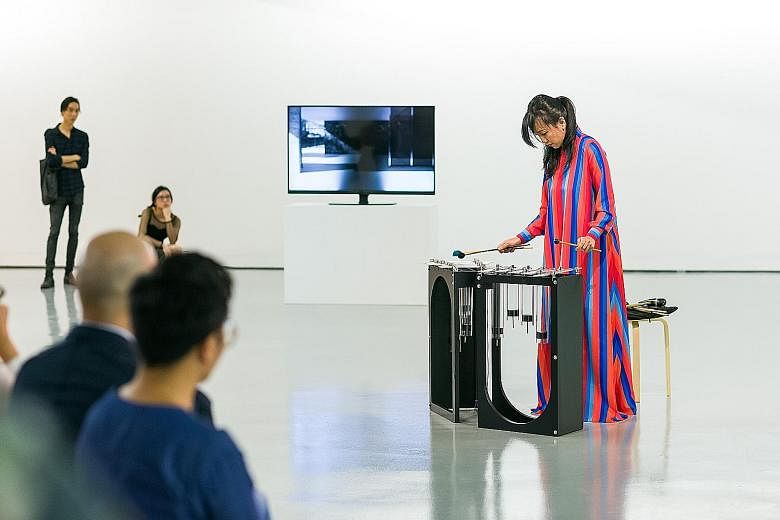Borders between traditions and mediums blur in Sriwhana Spong And Maria Taniguchi: Oceanic Feeling, a rich and vivid exhibition of works from the two artists.
The exhibition at Lasalle's Institute of Contemporary Arts Singapore is the first major survey of the practices of New Zealand artist Sriwhana Spong and Filipina artist Maria Taniguchi, who in their work - from videos to sculptures - weave together the sights, sounds and histories of different cultures, countries and genres.
Forging unlikely relationships and shining a light on the unfamiliar is an interest of Spong's. Her art, she tells The Straits Times, is inspired by encounters with people, places, animals and texts.
"This encounter with another voice sparks a series of questions or a particular curiosity and, from there, the work emerges. It's a way of exploring how to approach that which is generally considered 'outside' of us," says the 37-year-old.
-
VIEW IT / SRIWHANA SPONG AND MARIA TANIGUCHI: OCEANIC FEELING
-
WHERE: Gallery 1, Institute of Contemporary Arts Singapore, Lasalle College of the Arts, 1 McNally Street
WHEN: Till Oct 16, noon to 7pm (Tuesday to Sunday); closed on Monday and public holiday
ADMISSION: Free
"I enjoy exploring ways to undermine the traditional and still preserve ideas of what art is, what it should say, what it should and should not contain - approaches still influenced by Western arts' largely patriarchal and white history - and ways of saying 'yes' to the 'no' that you constantly hear no matter where you are from and what you do."
That is what Spong, who is of New Zealand and Indonesian descent, does with one of her works on show, Instrument B (Vivian).
The keyed metallophone, which is made of wood, acrylic, rubber and aluminium, is based on the tuning system of the Balinese gamelan orchestra, where pairs of instruments playing the same musical part are purposely detuned.
When played simultaneously, these instruments create a shimmering sound known as ombak.
"I was interested in exploring this vibratory space, this invisible body that opens up between each pitch - what the Balinese refer to as the 'inhale' and the 'exhale'," says Spong. "I wanted to make a work that was visual and auditory, a piece that could work on multiple senses."
When she started working on the instrument, she realised that the Western scale she was so familiar with was just one out of a vast array of ways - across cultures, instruments and time periods - to structure sound.
Instrument B (Vivian), which she created this year for the Singapore exhibition, is the second metallophone in a series she is working on. It is, she says, a way of mapping her encounters and the places she visits.
"The dream for the work is to slowly build up a personal orchestra that maps through form and sound of my own place, movements and meetings, structuring this into pitches that one day might all be played together," says Spong.
Instrument B (Vivian) is named after Singaporean musician Vivian Wang - part of avant rock outfit The Observatory - who chose the scale and performed on it during the opening of the exhibition. She will also perform on a couple of other occasions during its run.
Lasalle's Institute of Contemporary Arts Singapore suggested Wang as a possible collaborator, as "we feel that she is one of the most exciting experimental musicians... at the moment", says its curator Silke Schmickl.
Wang says when she was invited to design the scale for an instrument that would be named after her, it was "something which I thought was odd - yet it instantly made me possessive about it, in a good way".
And Spong describes the instrument as almost a sonic portrait: "The work sits between being a functioning instrument and a sculpture and escapes easy classification."
Coming from a mixed-race heritage, she says "this escaping of easy classification is an interesting and important element in my work".
She works across a range of mediums, from sculptures to videos, and through her art unites unexpected ideas.
Another of Spong's works, Villa America (2012), was made by dyeing silk in orange Fanta, a soft drink, using imbibed liquids as an attempt to bring the audience closer to the work by playing on the sensual memory of tasting and drinking.
This functions not just as a critique of homogeneity through colonisation and capitalism, but as a celebration of the collective.
While Taniguchi, who was born into a family of sculptors, has a particular fondness for clay, she showcases her mastery of diverse mediums and materials, including paint and video.
"As I come from a family of artists, I was aware of materials and processes at an early age," Taniguchi, 35, tells The Straits Times.
Growing up living and breathing art, she has also delved into documenting the process of making and seeing art.
For her video Untitled (Dawn's Arms) (2011), she travelled to the marble quarries of the island of Romblon in the Philippines, engaging a stone-carver to replicate the arms of German sculptor Georg Kolbe's bronze statue Alba.
Shots of the craftsman at work are interspersed with scenes from around the island.
The exhibition's curator, Ms Susan Gibb, 32, hopes visitors will have a rich experience with the material properties, such as the texture and medium, of each work.
"I hope that from this, the language of each work - the intelligence, porousness and resistance of each work's material, and how it is shaped, framed and observed - can lead people to an understanding of Maria's and Sriwhana's practices, their conceptual concerns and methodologies of working."


